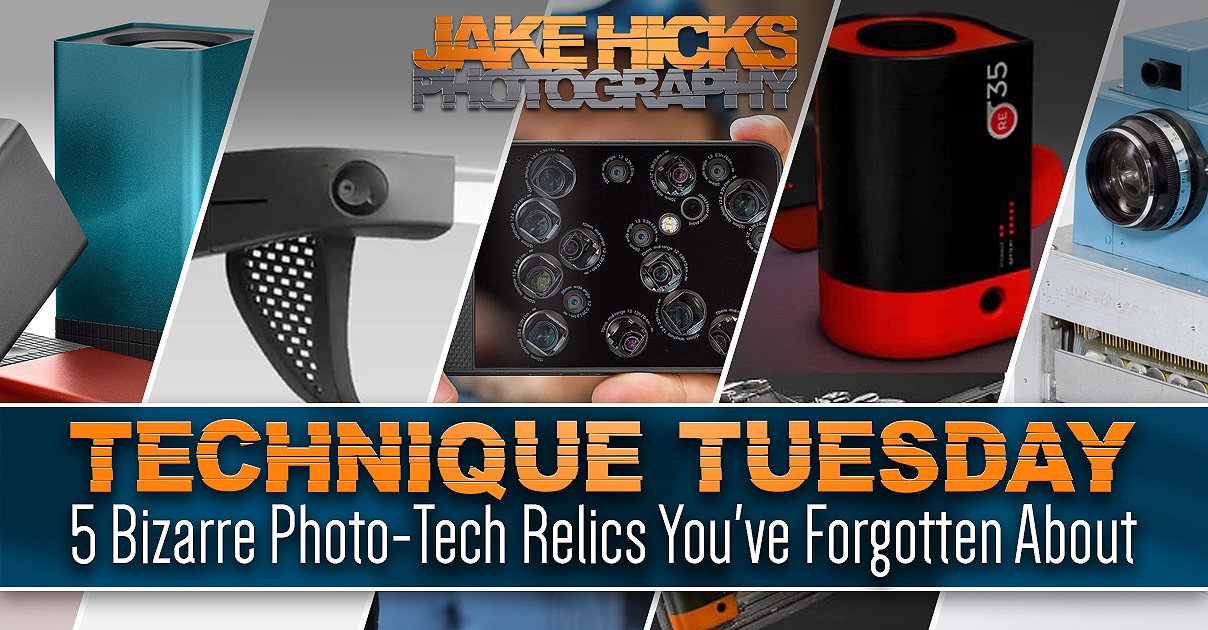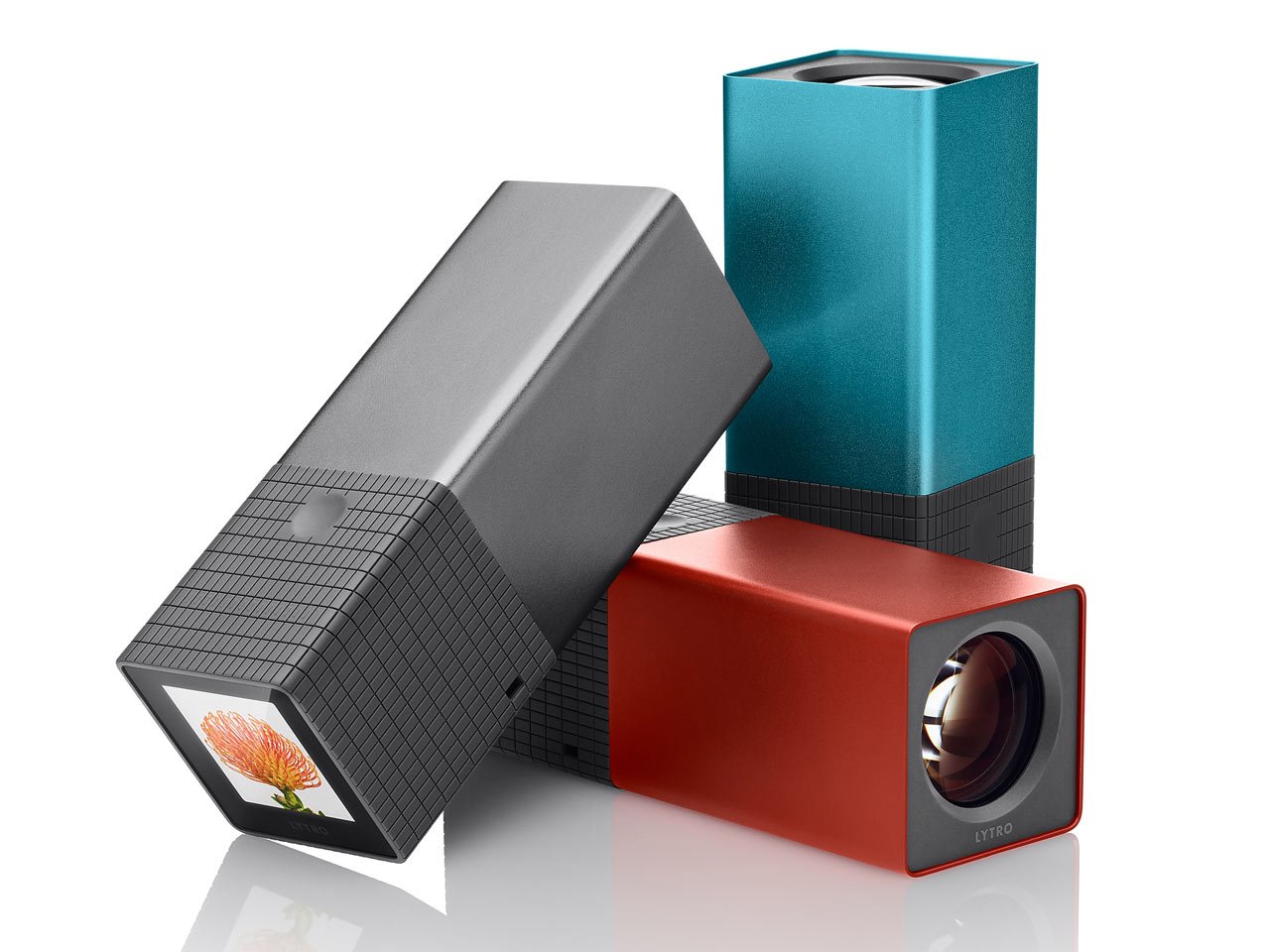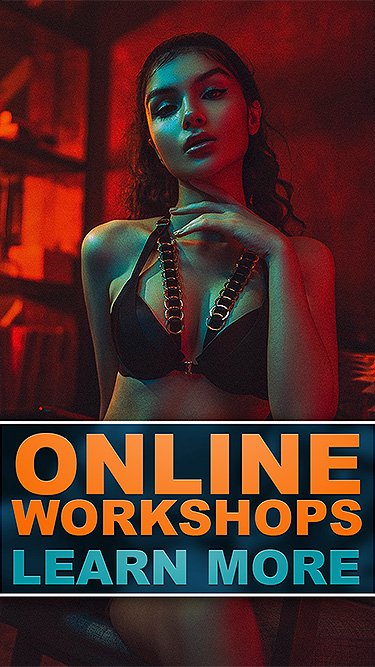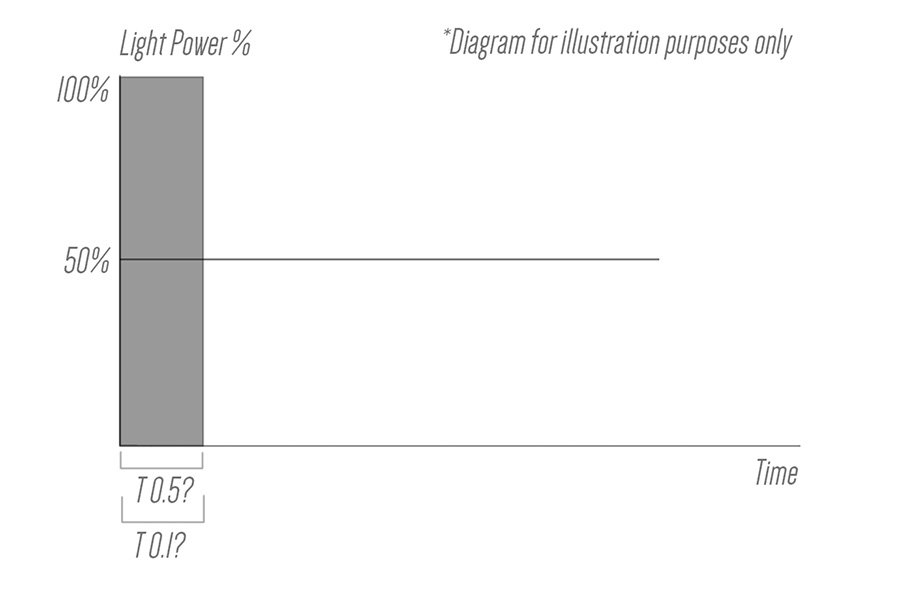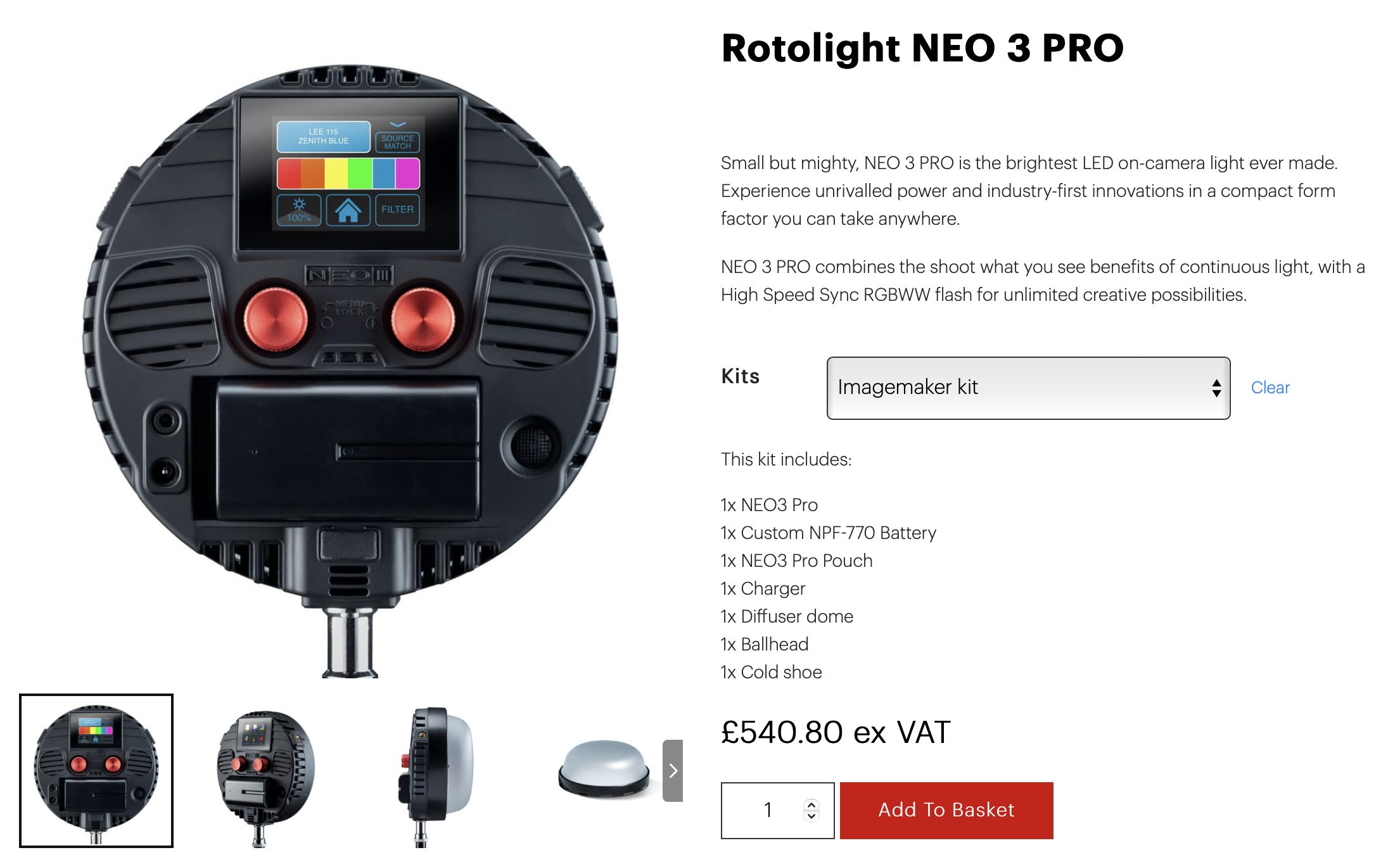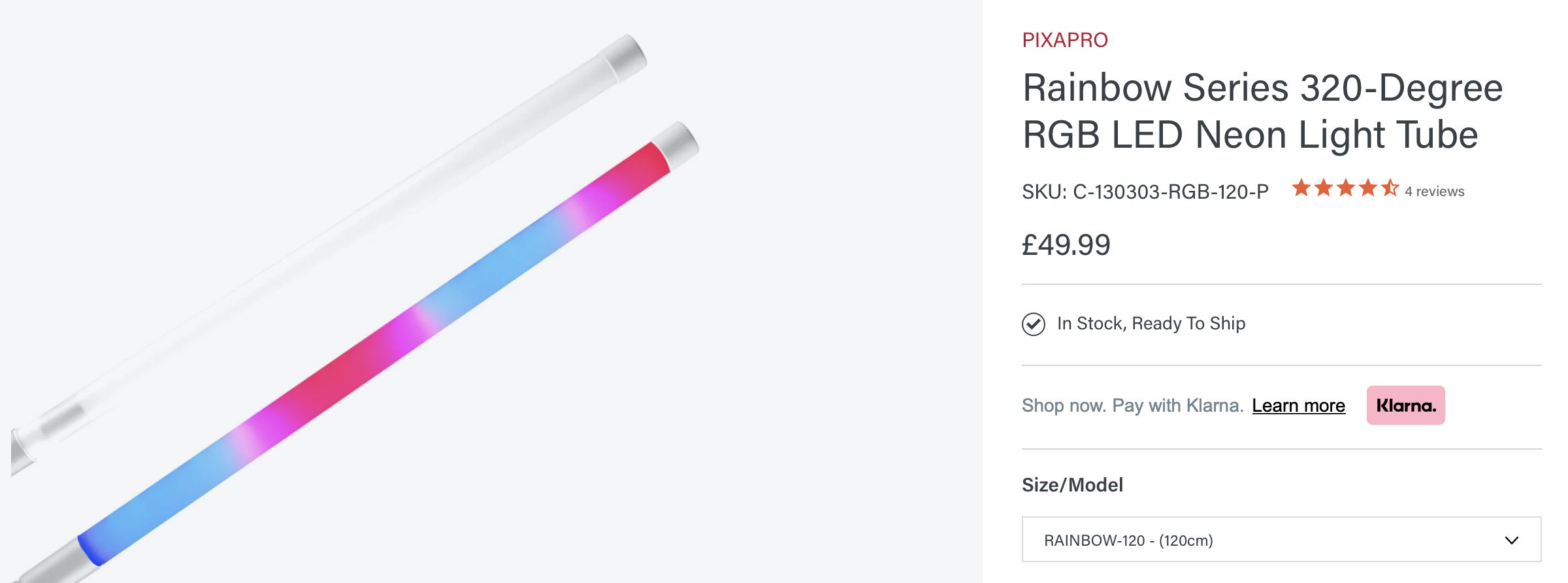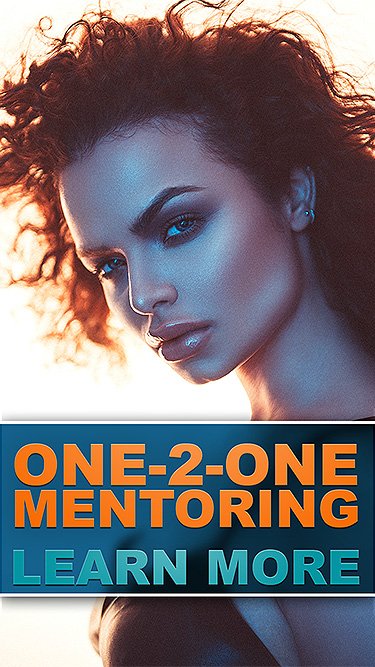I ordinarily share nerdy lighting setups and techniques, but with it being a very busy week for me, I thought I’d share something quick and lighthearted instead. Hopefully you’ll still appreciate this quick jaunt down this photo-related memory lane.
Recently an old friend and I were chuckling over some long-forgotten photo-tech that in hindsight, looks pretty damn bizarre! So here are 5 of the more commonly known ones that for better or worse many of us still remember.
One of the most unusual-looking cameras ever to make it to market, is the Lytro. But the Lytro didn’t just get attention for its Bizarre shape as it also enabled photographers to focus the image after it was taken.
The Lytro Camera
For those of you who were around 10 years ago, this quirky-looking camera was constantly in the press as it boasted a very bizarre feature. The Lytro camera could in fact take perfectly sharp images every single time. How? Thanks to its “proprietary light field science” that’s how! Essentially the little 5-inch long f2 camera and its light field sensor captured the entire scene in front of it, which consists of 11 million light rays of data (11 Megarays) and then displayed the image on its 1.5-inch rear LCD screen. The user could then choose the focal point after the shot had been taken.
Of course, this tech was running in real-time and capturing the scene constantly so there was no shutter delay or lag and no time is taken for the lens to focus either, resulting in a truly instant capture device that didn’t even require the photographer to choose a focal point in the frame as that could all be done later. At the time we grumbled that it took the creative spirit out of photography, as essentially re-focussing the image after the fact was seen as cheating somewhat. Granted the previous generation of photographers had said the exact same thing regarding autofocus. There was no skill to autofocus and again it was deemed as cheating. But unlike autofocus, Megarays never really took off in the photographic market.
Back in 2012 when the Lytro camera was released, this 1.2-megapixel monster sold for $399 and $499 for the 8GB and 16GB models, but the hype quickly died down. It could easily be argued that nearly $500 was a lot of money to pay at the time for a 1.2-megapixel camera. You have to remember that back then, Canon released its EOS 5D Mark III that boasted a 22.1 megapixels full-frame sensor and even Nikon managed to bring out a half-decent camera that year in the form of its D600 full-frame 24.3-megapixel sensor. Photographers were still chasing the ‘bigger number = better’ dream back then and Lytro offering to focus your images for you simply wasn’t enough to get this camera off the ground.
It wasn’t long before Lytro took their light-field tech and tried to implement it in other fields and in 2015 they pursued VR video capture cameras for use in CGI. Sadly this new-tech story ends like so many others as it was reported that Lytro was acquired by Google, although it’s rumoured that just the Lytro employees were acquired (further clarity is needed on that though).
So for now it looks like we’re all stuck focusing our own photos as the Megarays are sadly no more. Interestingly though, if you go to the www.lytro.com website, it relocates you to the Raytrix brand that is still using the light field tech to capture detailed moving parts in machinery and even medical science in 3D. It certainly looks like a clever end-use for the technology.
The light field technology shows how you can choose a variety of focal points after the image had been captured.
Apparently, a selection of colours was also available
This image best shows the small scale of the camera
Star in your very own sci-fi movie and make yourself a social pariah in the process. The very controversial Google Glass truly offered you a camera everywhere and anywhere.
Google Glass
This next item could be argued as more of a piece of tech or gadget rather than an actual camera, but Google Glass did highlight a few concerns regarding privacy and data collection that comes with having an ever-present and wearable camera.
Many have argued in the past that, ‘the best camera you have, is the one you have with you’ and Google Glass really pressed that mindset by releasing a camera that was designed to be with you at all times and worn at all times. Quite literally never miss another shot as your camera is always ready to go and a simple tap on the glasses frame can capture an image.
Google Glass was released in 2014 for a cool $1500, but to be fair, Google packed a lot of tech in a very small space, especially for the time. The camera was actually fairly impressive for its size as it boasted a 5MP camera and 720p video along with 16 GB of storage. So why didn’t this take off?
Putting aside the fact that Google suffers from ADHD and can’t focus on any project for longer than it takes to sip a venti Americano Misto before getting bored and wandering off, Google Glass was certainly met with a lot of resistance. Glass released its product to a select few qualified "Glass Explorers" (I’m not making that up) and some of those ‘explorers’ were even well-known photographers at the time who certainly sung its praises, but again, it couldn’t cut through the public negativity surrounding a product that we all feared was recording us at all times. In reality, the Glass could only actually record 10 seconds of video and it still had to be triggered by the user. But we all think those businessmen who seemingly wear those Bluetooth headsets to bed look like idiots, so imagine being sat in a bar with a chump wearing this thing strapped to their face the entire time! I think we were simply just too vain for this to garner any appeal to those with any self-respect.
As I mentioned a moment ago, Google Glass did bring to bear some serious questions about privacy concerns though. It was never clear if you were being recorded by it, so unless you were happy to be a social pariah or punching bag, you simply weren't going to be wearing this whilst visiting the mens room!
Having our phones with us and the camera that comes with it at all times was enough for us. The wearable camera died almost just as soon as it was released and a collective sigh of relief from introverts the world over was certainly sure to follow. Bear in mind that Glass was released to the public in May 2014 and in January 2015 Google announced it would stop producing the prototype. Google did then go on to release Google Glass Enterprise Edition in 2017 and in 2019, Google announced the Google Glass Enterprise Edition 2.
I’ll be honest, I had no idea they were still being made as I’d not heard anything about them in years. But alas it was not meant to be and in 2023 Google announced they’d discontinue the Enterprise Edition 2 and all support ceased later that same year.
Granted, I don’t think this product was ever targeted at photographers specifically, but the camera that’s always with you is an enticing idea. After all, I’m sure we can all agree that there are plenty of fantastic shots we’ve all missed due to not having a camera or simply not being fast enough to get set up. I assume a Google iris implant is just around the corner and having ads beamed directly into your retina every three and half minutes will be a small price to pay for us being able to capture the cat falling off the sofa.
Google Glass had several models over the years
Plus they could even be attached to your prescription glasses too
What started as an April Fools joke, soon escalated into a cult following. But is the 35mm digital film canister destined to remain a joke forever?
35mm Digital Films
This next one is more of a series than an actual product, but oddly, it all started with an April Fools joke. Back on April 1st 2011, design company Rogge & Pott posted about their latest ‘product’, the Re-35. Essentially the idea behind it was to use a flexible sensor that would lay across the film plane of any 35mm camera and the images captured were then stored in the 35mm canister ready to be downloaded afterwards.
The April Fools got a little out of hand at the time because the joke seemed legit, it seemed like such an obvious solution to revive all of those old cameras that we now only use as ornaments behind us in Zoom calls. Sadly, it later came out that it was indeed an April Fools and once again our old cameras were put to rest.
At the time the design company had to put out a disclaimer stating it was fake, but they also had this to say “there is a gigantic community of photographers with analog equipment out there that is desperately waiting for a product like this to come along”. As disappointing as this April fool's news was, they were right, there indeed were a ton of people who were desperately wanting a product like this.
Fast forward to 2018 and a very similar product appears that is trying to make the joke a reality thanks to the persistence of the Hong Kong based ‘Film 35’ product.
Film 35 is extremely similar in design to the fake Re-35. A 35mm canister attached to a flexible-looking sensor strip that you inserted into your camera. The Film 35 even boasted some decent specs too. You could shoot jpegs and even raws, the resolution was 12mp and it even had ISO settings from 100 to 12800. It had a battery life of 150 shots and you could store images via Micro SD plus it even had external WiFi! This was shaping up to be a very legit product and I for one wanted one.
Sadly, funding for Film 35 fell short and in my opinion, I really feel like this was a marketing issue as it looked to be a very promising product. Ironically, had they gotten the original April Fool's design agency Rogge & Pott to promote this, this ingenious little product may well have made it to market. The wait continues for another contender to take up the digital 35mm film canister mantle.
Touted specs of the Film 35 digital film canister
Resulting image taken with the digital sensor on a 35mm analogue camera
The Light L16 camera certainly turned a few heads with its very distinctive look, but was its camera-bag-in-your-pocket approach to photography enough to ensure its success?
Light L16 Camera
Some of you may instantly recognise this very odd-looking camera and the promo images of its SIXTEEN lenses certainly gained a lot of attention. In 2017 the company ‘Light’ released the L16 camera as a “breakthrough optics design with never-before-seen imaging technology to bring you the camera of the future.” But what did this odd-looking camera actually do? The camera boasted a focal range of 28mm up to 150mm and it delivered 52mp images all while being only slightly bigger than a phone. The camera was essentially trying to put your entire camera kit of DSLR and lenses in your pocket and for the most part, it succeeded.
Upon release, it was extensively reviewed, but sadly it didn’t perform well. Yes, it certainly took the full focal range of images as it promised, but it did this by stitching images together from its 16 lenses. When you hit the shutter the L16 took ten 13mp images and then stitched them together resulting in a monster 52mp final shot! There was really no other way to make a 150mm lens short enough to fit in your pocket, but during this stitching process, artefacts and mismatched seams between the shots were visible under closer inspection.
It was a very interesting idea and although adjustable focal ranges are possible in many smartphones, they zoom in using a ‘digital’ zoom which simply crops into the original shot you took. The L16 however was using optical lenses to capture various focal lengths and some of the full zoom 150mm shots of buildings are incredible considering this thing is only 24mm thick!
So again, why did it fail? It delivered what it intended and it seemed like a street photographers or nature photographers dream to have your entire lens collection in your pocket. The issue was the stitching of images and some disappointing results in low light. This would be fine for most casual photographers though as you really did have to look closely at the shots to see these flaws. The issue with all this was the target audience. The L16 cost a hefty $2000 at launch and that price point is going eliminate all but the most hardcore casuals. That was a hefty price tag certainly aimed at professionals, but sadly it just couldn’t deliver professional results.
The L16 was yet another piece of camera tech relegated to bizarre-looking memorabilia and in 2020 the company Light turned its attention to the mobile market. To be fair, it made total sense and there is infinitely more money to be made there and last I heard, they did actually make a new multi-lens Penta-camera that went in the Nokia 9 PureView.
The Verge Review - L16 Light Camera
DP Review - L16 camera manufacturer Light abandons consumer imaging
An image showcasing the impressive optical zoom variations of the Light L16
L16 promotional image
Light went on to develop a Penta-camera setup on the Nokia 9 PureView
Arguably one of the coolest looking cameras ever made, but behind this steampunk monster is the story of a corporate giant's downfall.
Kodak’s First Digital Camera
Many of the camera relics on this list could be argued as failures. Although the Lytro camera died very quickly, its light field technology paved the way to be used in other industries and even the short-lived L16 camera was a tech demo on how to pack optical lenses into a phone-sized package that ironically went on to be used in that market. But Kodak's first digital camera is far from a failure, it's just tragic how shortsighted Kodak was with the tech that they’d bizarrely pioneered and then swiftly abandoned.
The New York Times did a great write-up on this and I’ll link it below, but essentially in 1973, Kodak hired a 22-year-old lad called Steven Sasson to sit in some abandoned broom cupboard in the basement to work on some crazy new ideas. One of these ideas was involving this brand new piece of tech called a charged coupled device (C.C.D.). 2 years later Sasson emerges with what could arguably be described today as a prop from a steampunk movie, but it was in fact the very first digital camera.
Sasson initially struggled with the CCD as it couldn’t hold the quickly dissipating electric pulses of the image. Instead, he decided to use a new process called ‘digitalisation’ which instead turned the electric pulses into numbers that he ultimately got stored onto magnetic tape.
You have to remember, this was the early 1970s, home computers weren’t even available at this time, so this tech was certainly pushing the boundaries. Sasson’s first camera took 100-pixel by 100-pixel black and white images and the process was surprisingly fast. You took the shot and then 23 seconds later the image would be written to the tape. You then simply pop the tape out and display it on a TV.
This demonstration was given to the Kodak executives, but it failed to excite them and according to Sasson, “They were convinced that no one would ever want to look at their pictures on a television set.”
Sadly we know how this story ends as although Kodak were quite literally at the forefront of this technology, they were reluctant to develop a product that would take customers away from their colossal film sales market. This would be the start of their inevitable downfall and in 2012, Kodak filed for bankruptcy.
As I mentioned, the New York Times did a great write-up on this which I highly recommend you read as it is a crazy tale of how shortsighted major corporations can be when it appears as if the money will endlessly roll in. Regardless though, I’m so happy this steampunk-looking photo relic was preserved from Sasson’s dungeon as it's one of the coolest-looking functioning cameras out there.
Thank You
As always, thanks for checking out this article and spending a little bit of your day with me here. I hope you found it useful and if you left with a little more knowledge than when you arrived, it’s been worth it.
If you have any questions or comments, or if something doesn’t make sense, by all means, fire away in the comments below and I’ll do my best to answer what I can. Thanks again and I’ll see you in the next one.
Don’t forget to sign up to my newsletter to be sent all of these photo tips and techniques articles every month in case you miss one.
JHP Livestreams…
If you give this setup a go, I’d love to see how the shots turn out, so feel free to share them my way. One way to do that is via my Livestream. I Livestream every other Tuesday night via my FB Page and there I answer your questions, critique your shots, take community images into Photoshop to work on them and discuss all manner of lighting tips and techniques. I look forward to seeing you and your work there real soon. JHP Facebook Page

